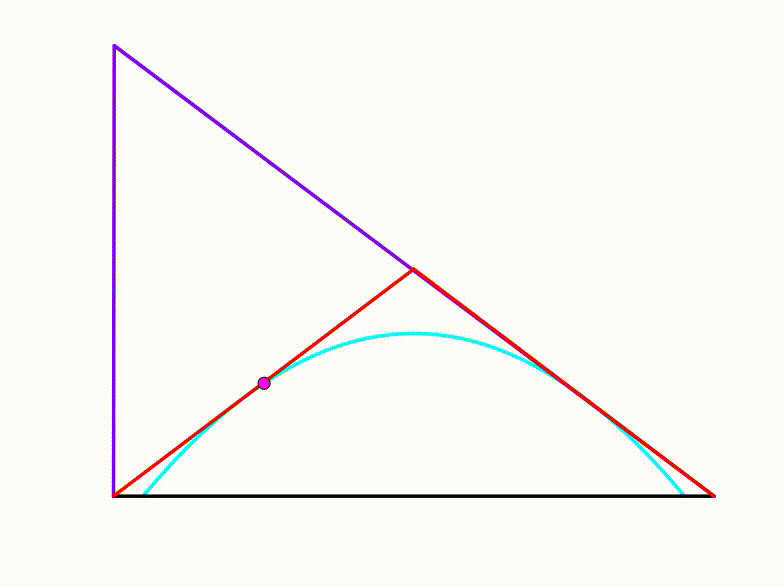Dynamic Geometry: P136
 The diagram shows a purple triangle. Its horizontal base in black measures
and its altitude is always equal to
. Its apex moves horizontaly freely. The triangle's nine-pont circle's center (pink point) traces a
locus
(cyan curve). The red triangle is drawn so that its base is the black segment and both red segments are tangent to the cyan curve. The area bounded by the cyan curve and the two red segments can be expressed as:
The diagram shows a purple triangle. Its horizontal base in black measures
and its altitude is always equal to
. Its apex moves horizontaly freely. The triangle's nine-pont circle's center (pink point) traces a
locus
(cyan curve). The red triangle is drawn so that its base is the black segment and both red segments are tangent to the cyan curve. The area bounded by the cyan curve and the two red segments can be expressed as:
where , , , and are positive integers. and are coprime, so are and , so are and . and are square-free. Find .
The answer is 54.
This section requires Javascript.
You are seeing this because something didn't load right. We suggest you, (a) try
refreshing the page, (b) enabling javascript if it is disabled on your browser and,
finally, (c)
loading the
non-javascript version of this page
. We're sorry about the hassle.
Let the purple triangle be A B C , where A B = 4 is the horizontal base. Let the midpoint of A B , M be the origin ( 0 , 0 ) of the x y -plane, then A = ( − 2 , 0 ) , B = ( 2 , 0 ) , and C = ( u , 3 ) ; and the midpoints of C A and B C be L ( 2 u − 1 , 2 3 ) and N ( 2 u + 2 , 2 3 ) respectively.
Let any point on the locus or the center of the nine-point circle of △ A B C be P ( x , y ) . We note that the center of nine-point circle is also the circumcenter of △ L M N . Therefore P is the intersection point of the perpendicular side bisectors of L N and M N . Let the midpoints of L N and M N be E ( 2 u , 2 3 ) and F ( 4 u + 2 , 4 3 ) respectively. Then the equations of
⎩ ⎪ ⎨ ⎪ ⎧ E P : F P : x = 2 u x − 4 u + 2 y − 4 3 = − 3 u + 2 . . . ( 1 ) . . . ( 2 )
Then the x -coordinate of P , x = 2 u . Substituting u = 2 x in equation ( 2 ) :
x − 4 2 x + 2 y − 4 3 1 2 y − 9 y = − 3 2 x + 2 = 4 − 4 x 2 = 1 2 1 3 − 4 x 2
Therefore the locus is a parabola. The area under a parabola is 3 2 of the area of the rectangle that encloses it. The area of under the locus,
A p = 3 2 ⋅ y ( 0 ) ⋅ 2 ∣ x ∣ ∣ ∣ ∣ ∣ y = 0 = 3 2 ⋅ 1 2 1 3 ⋅ 2 2 1 3 = 1 8 1 3 1 3
Let the height of the red triangle D M = h . Then D = ( 0 , h ) and the equation of A D is x + 2 y = 2 h ⟹ y = 2 h ( x + 2 ) . Let the point where A D is tangent to the locus be Q . Then the gradient at Q on the parabola is the same as that of A D or
d x d y = d x d ( 1 2 1 3 − 4 x 2 ) = − 3 2 x = 2 h ⟹ x = − 4 3 h
Since Q satisfy the equation of A D and the equation of the locus, we have:
1 2 1 3 − 4 x 2 1 3 − 4 x 2 1 3 − 4 9 h 2 9 h 2 − 1 2 h + 5 2 ⟹ h = 2 h ( x + 2 ) = 6 h ( x + 2 ) = − 2 9 h 2 + 1 2 h = 0 = 3 8 − 3 2 Substituting x = − 4 3 h The tangent point is below the x -axis for h = 3 8 + 3 2 .
The area of △ A B D , A △ = 2 1 ⋅ 4 h = 3 1 6 − 3 4 and the area enclosed by the locus and the two red segments is
A = A △ − A p = 3 1 6 − 3 4 3 − 1 8 1 3 1 3
The required answer is p + q + m + n + i = 1 6 + 3 + 4 + 1 3 + 1 8 = 5 4 .